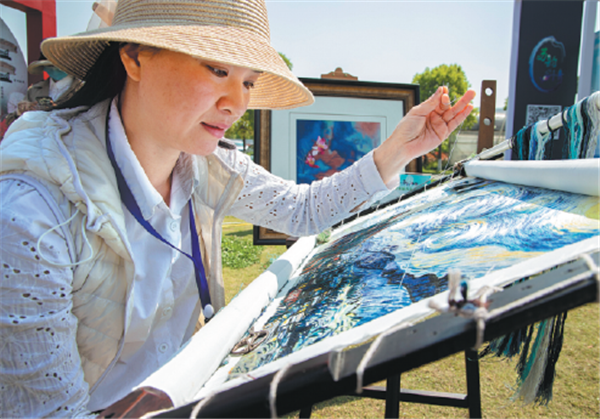Intangible cultural heritage finding its market online

A craftswoman showcases her skills in crewel embroidery at a rural tourism promotional event in Changzhou, Jiangsu province in April. [Photo/FENG JIANGJIANG for CHINA DAILY]
In the wake of the COVID-19 outbreak, the internet has become a popular arena not only for shopping in China but also for promotion of the country's intangible cultural heritage.
"Promoting ICH online is an inevitable result with the development of the times," He Yun'ao, head of the Institute of Cultural and Natural Heritage of Nanjing University, told China Intellectual Property News.
The trend is emerging amid increased use of the internet, the country's advocacy of an "internet plus culture" and increasing social requirements for cultural diversity, He added.
The internet helps to expand the spread of ICH and its promotion to the world, he said.
For example, during the annual Cultural and Natural Heritage Day of China on June 13, a unique cultural tour of many locations and crafts was broadcast via livestreams.
Jin Tieling is a national-level inheritor of Beijing silk flowers. "The Beijing silk flower has a long history and reached its peak popularity during the Qing Dynasty (1644-1911)," Jin said in a livestreamed class during the event.
The flower is made of silk fabric and is completed in steps involving chiseling, dyeing and rubbing, Jin explained while demonstrating the craft.
"Making the silk flower helps nurture spirituality and you will feel delighted putting your heart in it," Jin said.
The online class of Beijing silk flowers and another ICH-themed livestream following it attracted more than 1.4 million views on the day.
Data from video-sharing platform Douyin, known as TikTok overseas, showed that as of May 31, there had been 1,318 national ICH items in videos shared on the platform.
As of the end of May, 48 million videos involving the national-level ICH items have been viewed 200 billion times and received about 6.5 billion likes on the platform.
As ICH gains in popularity online, there is huge market potential.
Wu Cheng, in her 30s, is a fourth-generation inheritor of crewel embroidery in Changzhou, Jiangsu province.
Learning the craft from her mother, Wu said she is upgrading her crewelwork to attract new customers.
"The pattern of crewelwork is distinguished by its three-dimensional stitches, but is hard to expand in the marketplace due to its traditional style," Wu said.
"We recreate embroidery patterns and promote the handicraft in a way to appeal to young people," she said.
Wu founded a crewelwork company and has sold derivative products on online platforms, such as Taobao and Douyin.
Online marketing has helped to draw more attention and has attracted clients who are interested in crewelwork, Wu said.
During the Cultural and Natural Heritage Day, ICH-themed livestreams were staged around the country.
Through livestreaming platforms, the Guangxi Zhuang autonomous region organized inheritors to demonstrate a variety of traditional techniques. Together they recommended a total of 212 local ICH commodities and encouraged viewers to place orders.
The Yunnan provincial ICH protection center cooperated with six inheritors to showcase and promote local ICH items via livestreams on the Kuaishou app. The online promotions included techniques in making Pu'er tea and costumes of the Yi ethnic group.
"Many ICH products have found a huge online market, which implies growing needs for them and their enormous development space," He said.
"The promotion and inheritance of ICH are closely associated with the market," he said. "For those ICH items that have small market shares, the government needs to cooperate with individuals and nongovernmental groups to increase protection of them."

 Responsibilities of the SOCAAC
Responsibilities of the SOCAAC Experiencing Beijing 2023
Experiencing Beijing 2023